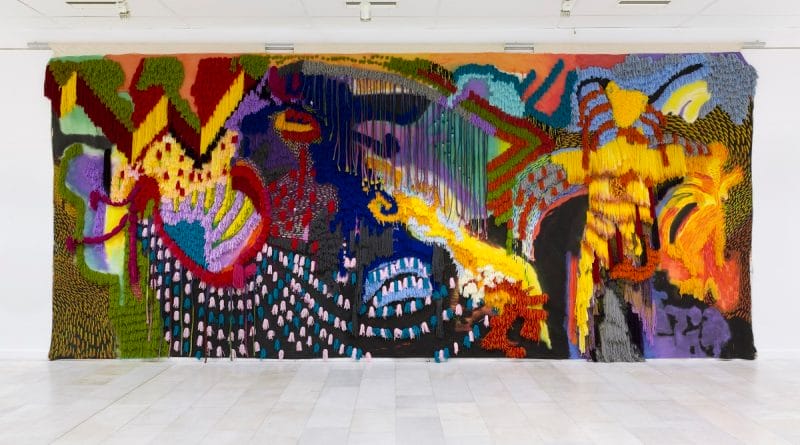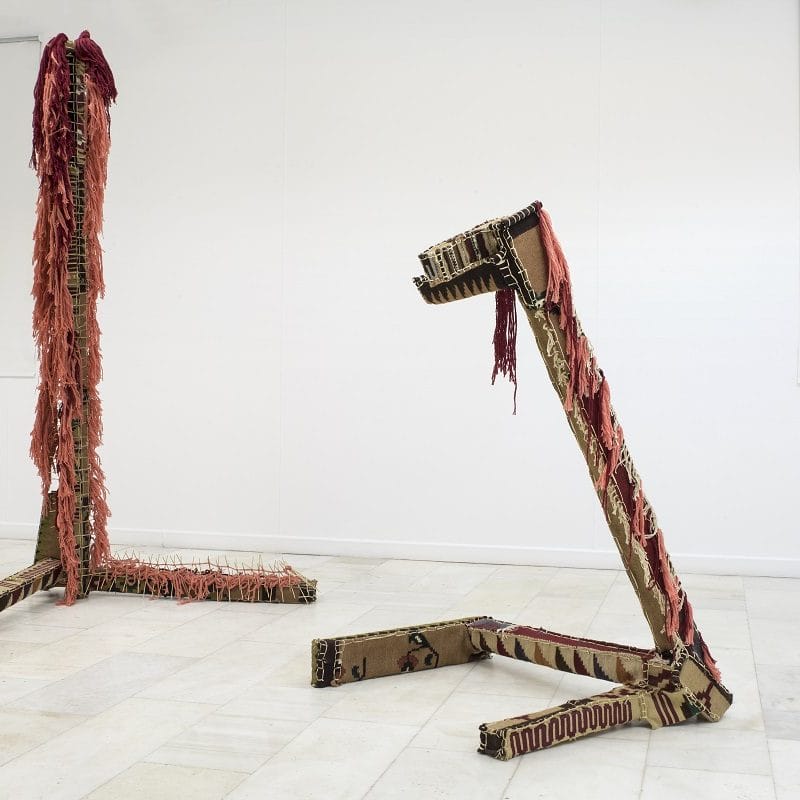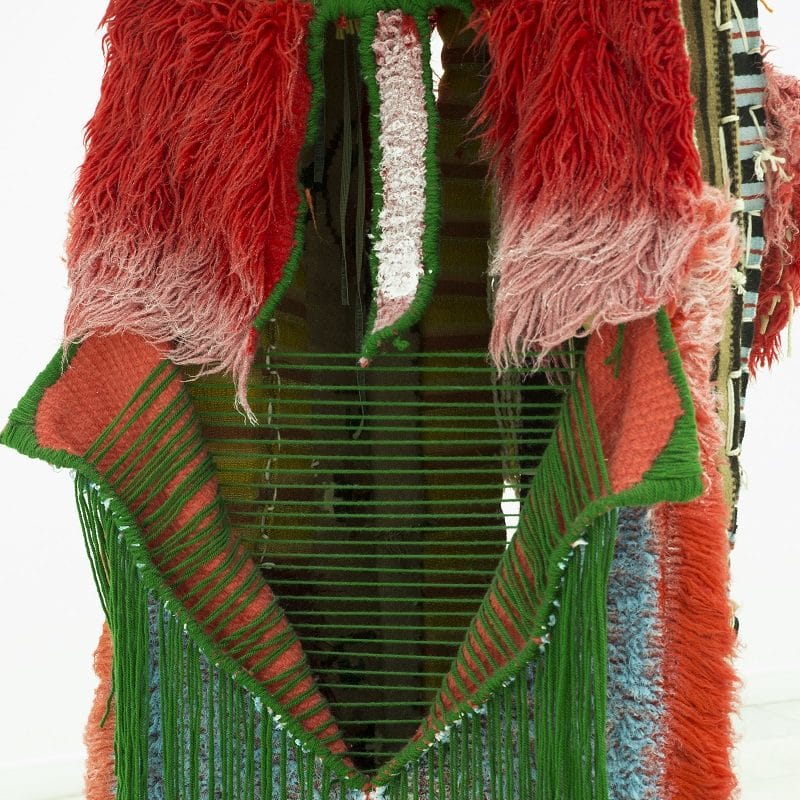MARO FASOULI
*Foto in evidenza: Maro Fasouli. Untitled, 2020, 700×300 cm. cloth, spray, pastel, thread. Private collection
Maro Fasouli (Athens, 1980) graduated from the School of Fine Arts in Athens and is one of the founding members of the Under Construction art collective (2008). Among the many exhibitions, residencies and performances in Greece and abroad in which she has participated, two recent solo shows are worth mentioning: “From Elbow to Wrist” presented at the Arts Centre by the Organization for Culture, Sport and Youth of the Municipality of Athens and curated by Christoforos Marinos (2020), and “Picnic in North Korea”, at CAN Christina Androulidaki Gallery. In addition, in 2021, she received the Stavros Niarchos Foundation Artist Fellowship from ARTWORKS. We encountered her works at the Alibi Gallery at Roma Arte in Nuvola. We sought to understand what research and what subjects lie underneath her materic tapestries through this interview.

How did you come to use textiles and fibres in your artistic practice?
My practice since 2007 is related to tradition, folk art, folk tales, and the way I approach them is mainly through archives and research. In 2014 I came across many weavers of the last century. My first concern was to understand their structure and language but also the purpose for doing them. At that point, I came across a book about folk tradition, written by one of the most acknowledged authors of that topic (Michalis. G. Meraklis). After a thorough search, I found most of his writings among others as well. It took me some years to sample and process all that information in a corpus of work.

Textile and body: how does this combination fit together in your artworks?
My latest work, From The Elbow to the Wrist, concerns measurement practices involving body parts. Drawing on the tradition of weaving, which has over the centuries been a privileged field of female occupation, my artwork focuses on how the body itself is used as a measuring unit in it. Specifically, the method I employ is the traditional practice of measurement by rolling yarn around the forearm – a method that is both a means of measurement and a measuring unit (the equivalent of 64cm). By focusing on the process of measuring, I highlight the practice of weaving itself, setting aside the decorative aspects of the final result, that is, the textile. In my sculptures, elements such as wool tassels and cuts (holes), which in traditional weaving are hidden within the textile, obscuring the manufacturing process, are allowed to remain visible to the viewer. Here, pieces of cloth (tassels) do not signal the termination of the textile, but are to be found scattered all around the piece, suggesting a construction process that makes its structural elements visible.
I revisit this traditional craft in terms of the practice itself, bringing to the fore connections amongst bodily practices, labour, and gender. Moreover, I articulate a diffferent kind of vocabulary for describing the aesthetic framework of traditional weaving – something that has always interested me.
As a nod to the so-called xoana, apotropaic figures that served as protection against all fear, I focus on the concept of the figure in general, and my own figure in particular, fully extended, as my size determines the scale of my sculptures. My materials (yarns, woven fabrics, reeds) are all characteristic of all forms of folk art.
What techniques do you use to create your works?
When I started dealing with traditional textiles I made a list of everything that this tradition forbids. When, for example, a traditional weaver made a mistake in weaving she would not keep the weave for some inferior use nor would she leave it in her drawer as this would expose her. She had two options. Either untie the braid to the mistake and fix it, or throw it away. The technique I use is based on all the errors of the textile such as the holes, the tearing, the non-useful tassels, without a draft, without a specific rhythm of repeating patterns.

How do you choose the materials?
The main idea is to work on the traditional heritage. My practice on that started some years ago, when I was surveying on the Greek traditional (anonymous) architecture of previous centuries. Thus I find tempting, in what I do now, to continue this search along with the tapestry techniques. This of course acts as a new idiom that combines two controversial principles, the inside and the outside. In other words, the craft of building a house, a men’s occupation, and the art of weaving which took place by women inside the house. By doing so, combining these two directions into one gesture, the boundaries of in and out as well as the discrimination between men or women, is no longer visible. Therefore someone can find in my work a variety of materials textures and methods. Wood and fabric, nails and sewing, iron, plaster and cloths. All these materials, either found or purchased direct my practice in the studio.

How important is the ‘craft’ practice in your opinion in ‘making art’?
In my practice, the decision making is guiding my craft and vice versa. I mean that I never predetermine what I am about to do by drawing sketches of it, as a tool of comprehension. I usually have a general idea, a vague shape of it in my mind, and that helps me to decide basic elements such as height, length etc. From this point on, decisions regarding shape and color take place. This procedure offers an argumentative method that proves for me to be a stimulating act in my art making. Craftsmanship is of course the main idea that leads my thoughts, and also perhaps the first impression someone gets by looking at my work, but to me it seems as an ambivalence condition.
Your works are very material and usually large in size. Does this ‘occupying space’ have a conceptual meaning for you? What relationship is established between your works and the space that hosts them?
I believe that this work needs to be seen in full strain. Shapes, colors and gestures imply the feeling of not being constrained during work, taking advantage of the vast amount of opportunities and perspectives. The feeling that I can stretch my arms and occupy the space that surrounds me is both liberating and familiar. Besides that, I also find interesting using my body as a measure technique, something that was also familiar to people in previous years. The title in my last work implied just that idea, “from the elbow to the wrist”, meaning a cubit, an obsolete unit of length. Thinking of that, the ways we passed on old habits as years got by, it seems to me that after all this work was an effort to approach again an aspect of traditional history and the place of the woman in it. Therefor it felt to me that I had to proceed in a superlative degree.
What are your sources of inspiration? What were – if any – the artists or artistic movements that influenced you?
I explore the proximity between weaving and architecture – a relationship that goes back centuries – and the function of textile as a fixed or portable protective screen. It suffices to consider the pioneering female Bauhaus artists, most characteristic amongst them Anni Albers, to grasp the importance of weaving for modernist abstraction and to comprehend the changeable nature and adaptability of this physical practice that brings to the fore tactility as the principal sense. Writing about Albers’ work, art historian Briony Fer remarks on another aspect, ‘weaving becomes more than a medium – say, like painting – and much more expansive, much more structurally embedded in its environment.’[i] Indeed, at times my tapestries are reminiscent of the graffiti that abound in Athenian streets. This is further highlighted in the monumental (3×7m), especially produced for the Art Centre, which is comparable to a wall painting.
[i] Briony Fer, ‘Anni Albers: Weaving Magic’, Tate Etc 44, Autumn 2018.
What does it mean for you to be an artist?
Being an artist is actually a way of comprehending. Every aspect of daily life comes through that filter and pervades every thought, each act, any interaction. Art is really into everything because it projects the main question in life. What if?
What project are you working on right now? And what are your plans for the near future?
Lately I have been dealing with the traditional speech, as well as with the weaving that is constantly in my practice. In the weaving process I am working on some new techniques exploring new ways of expression in relation to texts from staples of curses and curses that have been recorded as types of traditional folk speech as aphorisms.
Over the centuries, these aphorisms have been the only weapon of women and were served by them and other groups of citizens without clear rights in the form of oral speech and brought the shade of magic. The text of the narrative I am working on at the moment does not clearly show the boundaries between affection and hatred, curse and wish.













